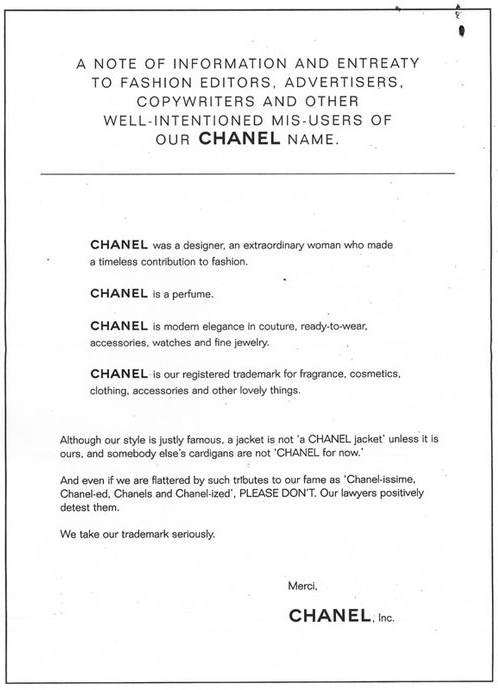Every business owner, no matter the industry, can learn from the practices of one brand in particular: Coco Chanel.
Many trademark owners fall into this all too-common misconception: receiving your registered trademark paperwork means that you have those federally-protected trademark rights forever. However, that is not the case, and Chanel has provided a great case study on the topic.
First, as you likely know, a trademark is a phrase, word, symbol, (product) shape, or logo used by a company/merchant/manufacturer for the purpose of identifying its goods, as well as to distinguish those goods from those made or sold by other companies. Simply put, the purpose of a trademark is to distinguish or differentiate that company’s products/services from a competing business’, which is precisely how a company can build a reputation. Therefore, you could say a trademark (when used properly) also allows your brand to grow a reputation that allows customers to automatically invest in you as a “luxury brand”. It’s actually hard to imagine how you could become a “luxury brand” without doing so. This perspective also helps to explain the vital importance in protecting your trademark. After all, unlike the majority of other forms of intellectual property, trademark rights can last in perpetuity if, and only if, they’re maintained properly.
Chanel has made no qualms about their position: they not only recognize this value in brand protection, but they have exemplified a trademark owner’s duty to monitor and uphold their trademark. Chanel has trademarked both it’s interlocking “C” logo, as well as the name “Chanel” on a federal level, which has made the brand automatically recognizable.
There are multiple factors that can contribute to a trademark owner losing their federally registered trademark rights, which can range from factors as simple as failing to file renewal paperwork at mandated times, to failing to use the name in commerce, to (what the most well-renowned, largest brands can fall victim to): “genericization”, which is what can occur when the trademark owner loses the distinctiveness of the mark. This can occur when a name becomes so well known that it becomes synonymous with a “thing”. For example, “Kleenex”, “Xerox”, and “escalator” were all once trademarks that became too generic over time.
Once a trademark/word merely describes, lists out, or names a characteristic or quality of a good or service, it no longer becomes distinctive, and therefore can not longer be used as a federally registered trademark. Remember “distinctiveness” is one of the gatekeepers into the ability to register a trademark in the first place. Therefore, again, a trademark must maintain its distinctiveness in order to distinguish the goods or services of the company in order to maintain its federal protection. Distinctiveness in a trademark must be protected, as it can be lost.
If a mark is subject to improper use (ie, it’s allowed to slip into what’s called the “public domain”) and is no longer descriptive of the brand itself, it will lose those federal registration rights, and would no longer be able to stand up to lawsuits. So, as you can see, it becomes incredibly important that trademark owners keep active watch over their trademark, and take appropriate actions to protect that trademark.
Enter: Chanel
Chanel has set a great example on a brand who has taken direct action to protect their trademark, and they have not played coy about the fact by any means. In 2009, the house began running ()the now infamous ads in Women’s Wear Daily that left no room for questions:
Creating a luxury brand can be a double-edged sword: on the one hand, building the brand’s reputation, which in itself is what allows the brand to become known as “luxury” is essential. However, that reputation, and those “specialty pieces” that the brand becomes known for, raise a heightened awareness, as well as more stringent actions required to protect that brand. Chanel was founded in 1909, and as one of the only brands in the world to survive both World Wars, as well as translate into the modern era. That fact alone is truly incredible. The fact that they have been able to maintain their trademark status is equally incredible from an intellectual property standpoint, as the brand has become somewhat synonymous (if not, simply known for), its interlocking “C” symbol, as well as looks and designs that are distinctly “Chanel” (according to magazines such as Vogue). In fact, recent runway reviews described looks from other brands as being “Chanel-esque” in nature, even though they had no origination from the Chanel house. This is clearly problematic from a trademark perspective.
This is precisely why Chanel has taken such seemingly overt, or maybe even “harsh” steps to protect their trademark (just google “Chanel trademark cases). However, the letter published in WWD is an example of an extremely wise way that a brand can take steps to protect it’s trademark rights. This letter not only puts any potential infringers on notice that it is closely watching for infringement, but it also provides visible, tangible proof for courts that the fashion house is in fact taking every step possible to maintain the trademark’s distinctive characteristics. This could be the defining factor between a brand winning a court battle to protect those rights.
In Summary:
First and foremost, using Chanel as a case study shows that those distinctive factors that can allow a brand to register a federal trademark can also be the exact reason why a brand can become a “luxury brand”, setting it apart from the rest. These distinctive factors are what builds a brand’s reputation.
At the same time, those same factors that allow a brand to gain a reputation are the same reason why a brand’s distinctiveness can allow the brand’s distinctive factors to be misused, and diluted to the point of becoming generic over time. Therefore, it is critical that any trademark owner take all actions necessary to maintain it’s trademark right. Remember, maintaining your trademark rights are a privilege, not a right. Specific steps must be taken to protect your trademark- not just filing the appropriate renewal documents, but keeping a close eye on how your mark is being used in the public sphere and ensuring that your trademark maintain its distinctiveness over time.


LEAVE A COMMENT
View Comments